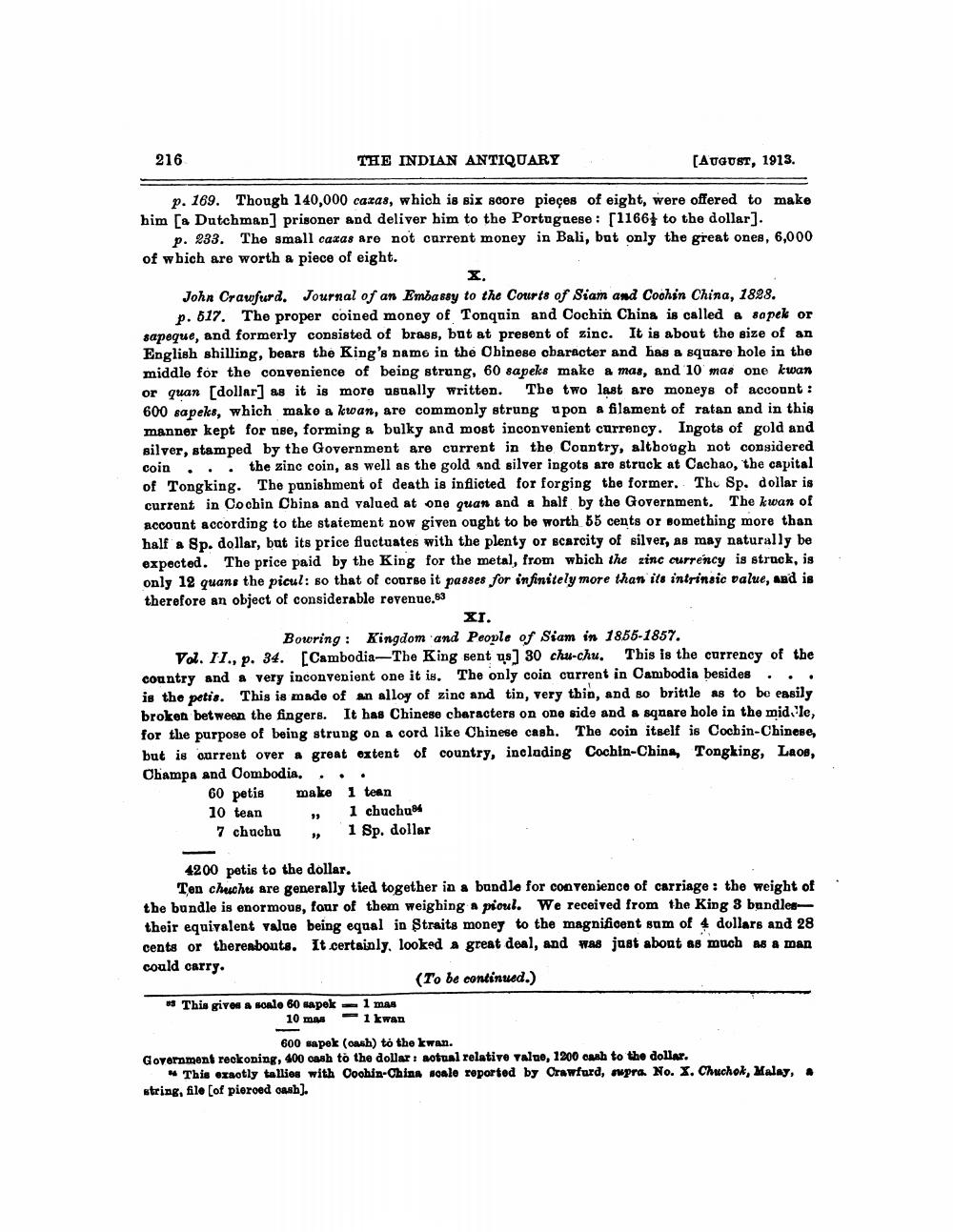________________
216
THE INDIAN ANTIQUARY
[AUGUST, 1913.
p. 169. Though 140,000 caxas, which is six score pieces of eight, were offered to make him [a Dutchman] prisoner and deliver him to the Portuguese: [1166 to the dollar].
p. 233. The small caxas are not current money in Bali, but only the great ones, 6,000 of which are worth a piece of eight.
X,
John Crawfurd. Journal of an Embassy to the Courts of Siam and Cochin China, 1828.
p. 517. The proper coined money of Tonquin and Cochin China is called a sapek or sapeque, and formerly consisted of brass, but at present of zinc. It is about the size of an English shilling, bears the King's name in the Chinese obaracter and has a square hole in the middle for the convenience of being strung, 60 sapeks make a mas, and 10 mas one kwan or quan [dollar] as it is more usually written. The two last are moneys of account: 600 sapeks, which make a kwan, are commonly strung upon a filament of ratan and in this manner kept for use, forming a bulky and most inconvenient currency. Ingots of gold and silver, stamped by the Government are current in the Country, although not considered ... the zinc coin, as well as the gold and silver ingots are struck at Cachao, the capital of Tongking. The punishment of death is inflicted for forging the former. The Sp. dollar is current in Cochin China and valued at one quan and a half by the Government. The kwan of account according to the statement now given ought to be worth 55 cents or something more than half a Sp. dollar, but its price fluctuates with the plenty or scarcity of silver, as may naturally be expected. The price paid by the King for the metal, from which the zinc currency is struck, is only 12 quans the picul: so that of course it passes for infinitely more than its intrinsic value, and is therefore an object of considerable revenue.83
coin
XI.
Bowring: Kingdom and People of Siam in 1855-1857.
Vol. II., p. 34. [Cambodia-The King sent us] 30 chu-chu. This is the currency of the country and a very inconvenient one it is. The only coin current in Cambodia besides is the petis. This is made of an alloy of zinc and tin, very thin, and so brittle as to be easily broken between the fingers. It has Chinese characters on one side and a square hole in the midle, for the purpose of being strung on a cord like Chinese cash. The coin itself is Cochin-Chinese, but is ourrent over a great extent of country, including Cochin-China, Tongking, Laos, Champa and Combodia,
60 petis 10 tean
33
7 chuchu 39
make 1 tean
1 chuchu
1 Sp. dollar
4200 petis to the dollar.
Ten chuchu are generally tied together in a bundle for convenience of carriage: the weight of the bundle is enormous, four of them weighing a pioul. We received from the King 3 bundles their equivalent value being equal in Straits money to the magnificent sum of 4 dollars and 28 cents or thereabouts. It certainly, looked a great deal, and was just about as much as a man could carry.
(To be continued.)
This gives a scale 60 sapek
10 mas
1 mas
1 kwan
600 sapek (cash) to the kwan.
Government reckoning, 400 cash to the dollar: actual relative value, 1200 cash to the dollar.
This exactly tallies with Cochin-China scale reported by Crawfurd, supra. No. X. Chuchok, Malay, a string, file [of pierced cash].




